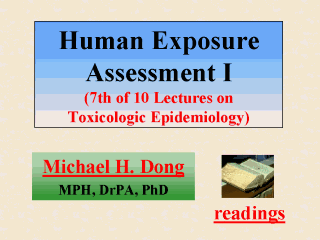| front |1 |2 |3 |4 |5 |6 |7
|8 |9 |10 |11 |12 |13 |14 |15 |16 |17 |18 |19 |20 |21 |review |
 |
This is the
seventh of 10 lectures on toxicologic epidemiology. It is intended to provide the students
with a detailed description and an expanded discussion on human exposure assessment (HEA),
which if nothing else is a key component of the health risk assessment process (RA). The
interrelationships among RA, epidemiology, toxicology, and public health were the subject
of discussion in the first four lectures. In this lecture, special attention is also given to the basic applications, the general techniques, the advantages, and the limitations of the direct measurement methods commonly employed in HEA. These direct measurement methods, almost all in the form of human biological monitoring, are designed to measure the internal dose of a chemical or biological agent present in the human body. Indirect measurement methods used in HEA will be covered in Lecture 8. The titles of the 10 lectures are: (1) Toxicology and Epidemiology; (2) Public Health and Risk Assessment; (3) Toxicology and Risk Assessment; (4) Epidemiology and Risk Assessment; (5) Toxicologic Side of Epidemiology; (6) Epidemiologic Side of Toxicology; (7) Human Exposure Assessment I; (8) Human Exposure Assessment II; (9) Characterization of Health Risk; and (10) Toxicologic Epidemiology. |